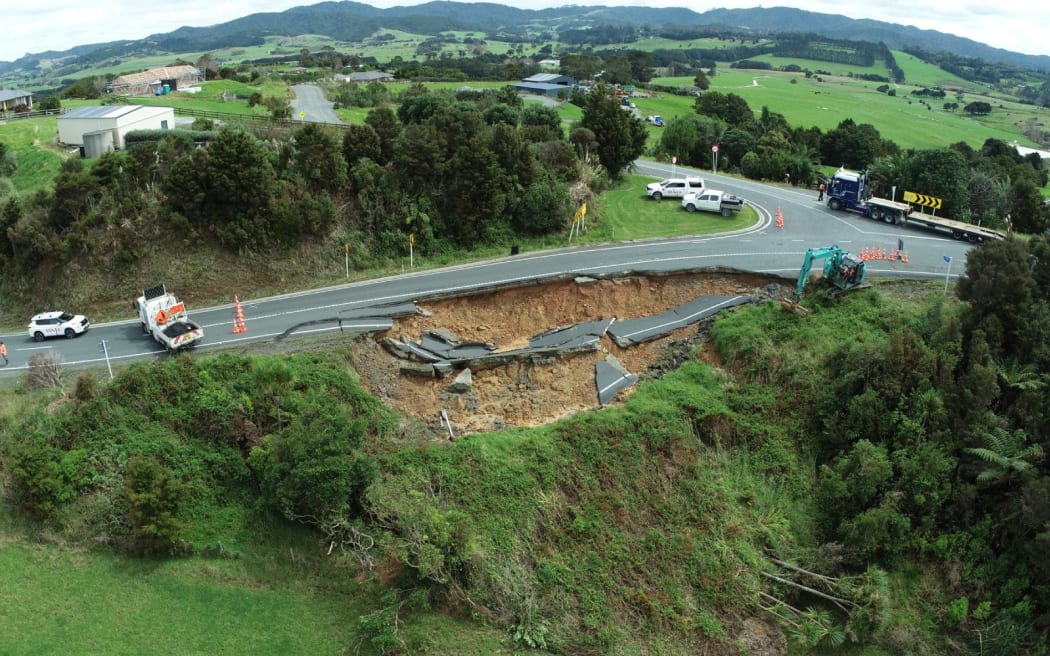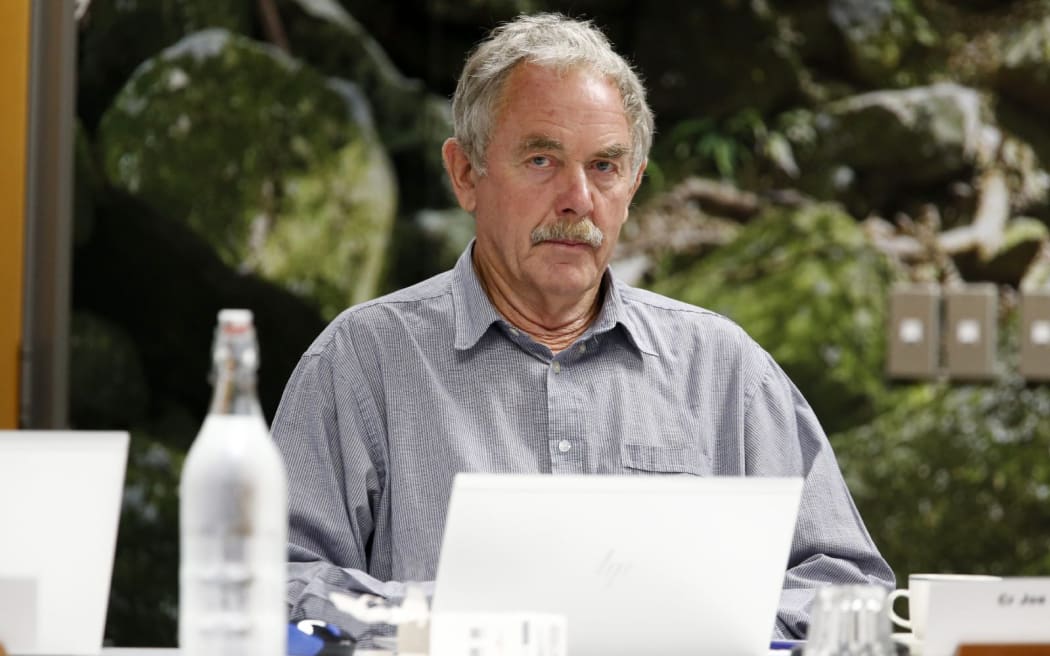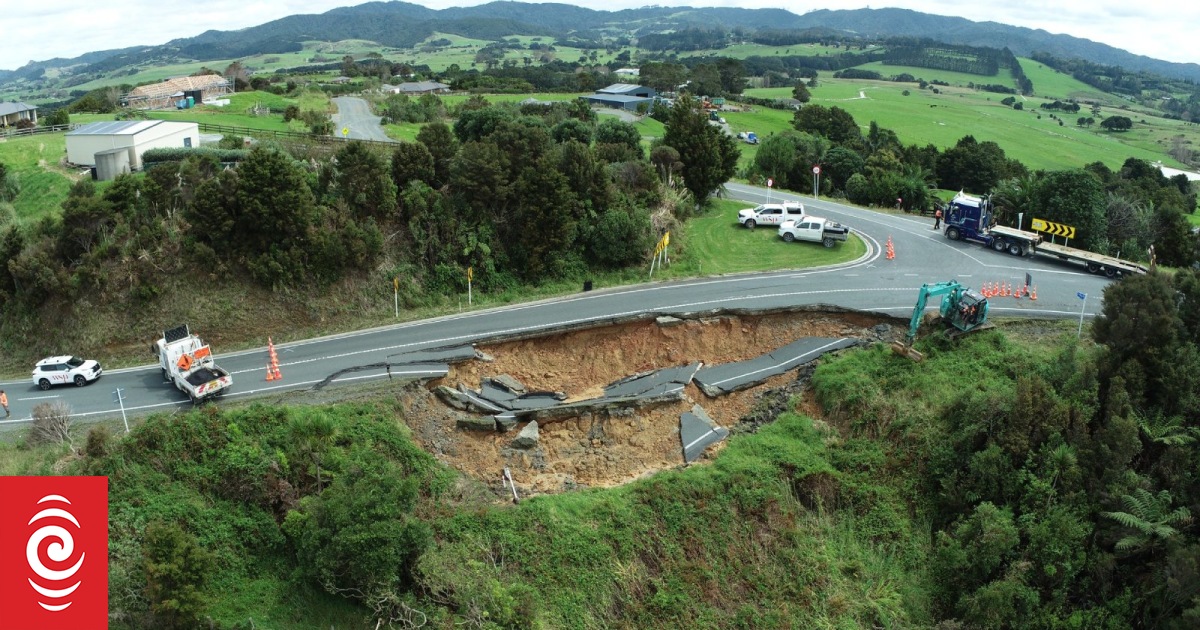
Underslip on Kaiwaka-Mangawhai Road which has done time as a Brynderwyn SH1 closure diversion route.
Photo: Northern Advocate / Kaipara District Council
Te Tai Tokerau councils are warning $250 million is needed to sustainably fix ailing local roads as roading infrastructure damage spreads like smallpox across the region.
There have been more than 1770 live slips across Northland’s 5755km of local roads in the wake of Cyclone Gabrielle and seven other major Northland weather events since July 2022.
More than 1000 slips were spread along the most crucial 1110km of these local roads before Cyclone Gabrielle – averaging one slip per kilometre of road. The cyclone and February 24 Mangawhai rain event added another 645 slips to these most crucial local roads.
Northland Mayoral Forum chair Vince Cocurullo said Cyclone Gabrielle further seriously exacerbated the roading infrastructure damage, spreading across the region like smallpox.

“The current estimate to repair and improve Northland’s local roading network is $250m. This funding is essential to provide Northland with a safer, more resilient local road network,” Cocurullo said.
More central government money was needed, after what had been decades of its underspending.
Cocurullo said it was about providing a sustainable, but not gold-plated fix for the region’s roads.

Northland Mayoral Forum chair Vince Cocurullo.
Photo: Northern Advocate / Michael Cunningham
His Northland Mayoral Forum message was delivered loud and clear to Minister of Local government Kieran McAnulty on Monday in his live link into the meeting.
Cocurullo also sent a new Northland Transportation Alliance report to Minister of Transport Michael Wood, along with Northland MPs Kelvin Davis, Emily Henderson and Shane Reti.
The eight major weather events – including Cyclones Gabrielle and Hale, Auckland Anniversary weekend heavy rainfall in Mangawhai and the deluge that also shut State Highway 1 over the Mangamukas – brought a $75m damage bill for the 2022/2023 financial year.
Pre-Cyclone Gabrielle damage totalled $23.7m (Far North $18.4m, Whangārei $3.5m and Kaipara $1.8m). Cyclone Gabrielle added to that with an early $50m repair estimate (Kaipara $23m, Whangārei $20m and Far North $10m).
Cocurullo said there was also the almost $120m to bring the Brynderwyns SH1 bypass diversion routes through Kaipara and Whangārei local roads up to scratch as sustainable alternatives. This included $52m for Paparoa-Oakleigh Rd and $10m for Cove Rd.
He said a further estimated $36.28m was needed to repair just 10 percent or 116 of Northland’s local road slips.
Cocurullo said slip and damage assessments had been completed for only the most crucial 40 percent of local roads.
These were ranked based on the degree to which they served forestry, schools, marae, churches, quarries, residential areas and land use such as avocados or dairying – as well as how wide and how remote they were.
He said slip damage was so bad that affected local roads had to be reduced to a single lane.
More than half of the 645 new post Gabrielle/24 February Mangawhai rain event slips were the more serious underslips – where roading infrastructure slips out from underneath the road.
Cocurullo said eight of Northland’s local roads were still closed.
Underslips dominated these remaining closures on four of the five affected Whangārei District Council (WDC) roads – Finlayson Brook, Shoemaker, Waipū Caves Rds and in Whangarei Memorial Drive on Parihaka. An overslip that had fallen onto the road at Whangārei Heads’ Stuart Rd was the fifth closure.
Underslips affected Tangowahine’s Avoca North Rd and Mahuta Gap Rd near Dargaville. Mangawhai’s Devich Rd was still closed, because of bridge damage
Cocurullo said a further 67 local roads were still down to a single lane (WDC 43, KDC 19 and FNDC five).
He said local detour roads bypassing SH1 through the Brynderwyns were getting increasingly damaged.
Regional Transport Committee chair Joe Carr said it was good to see the government had put funding towards some of the region’s earlier weather-damaged local road repairs, but more was needed.
He said people had not yet taken on board that the weather events battering the region since July last year were not aberrations.
They were part of a new normal the region had to lean into.

Regional Transport Committee chair Joe Carr.
Photo: Northern Advocate / Michael Cunningham
Carr said roading funding needed to be at a level where extreme weather damage and normal scheduled roading maintenance could both be done.
He said “drainage, drainage, drainage” was an essential roading repair component.
More rain falling meant more groundwater backing up against the foundation structures on which the roads were built. This meant increasing force pressing against these foundations which simply burst and disintegrated in heavy weather as a result, causing underslips.
Carr said there needed to be more investment in developing local skills and resources to build resilience into Northland’s roading network repairs, rather than having to rely on large companies from outside the region doing the job.
He said pre-emptive main route roading resilience work needed to be done, via major investment.
Carr said fixing areas of poor stability before the road dropped away in an underslip was up to 30 times cheaper than doing so after the slip happened.
Work being done to address main route access such as through SH10’s Waipapa also meant addressing surrounding catchments, in the case of this location, investigation into an upstream Kerikeri River detention dam illustrated the point.
Local Democracy Reporting is Public Interest Journalism funded through NZ On Air.



